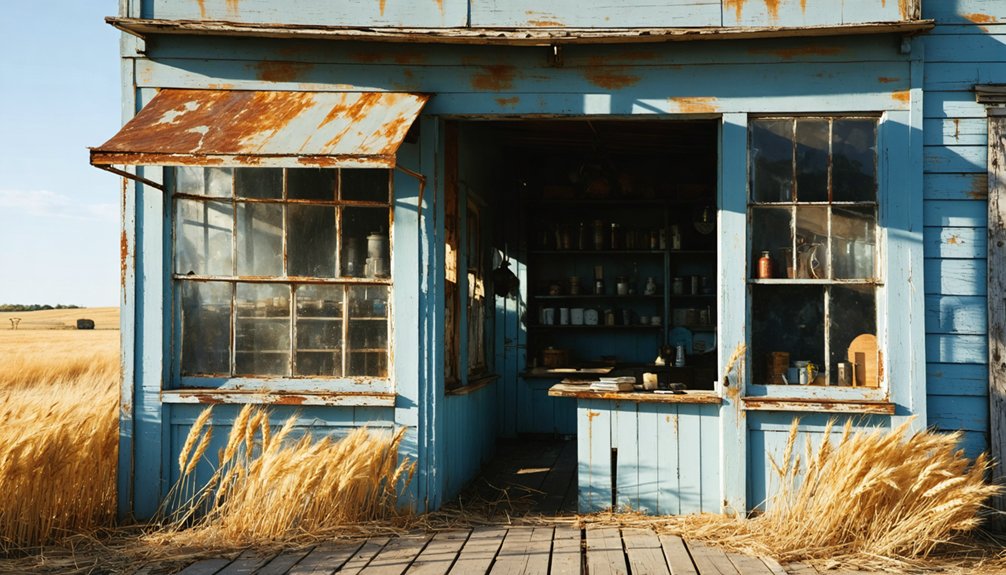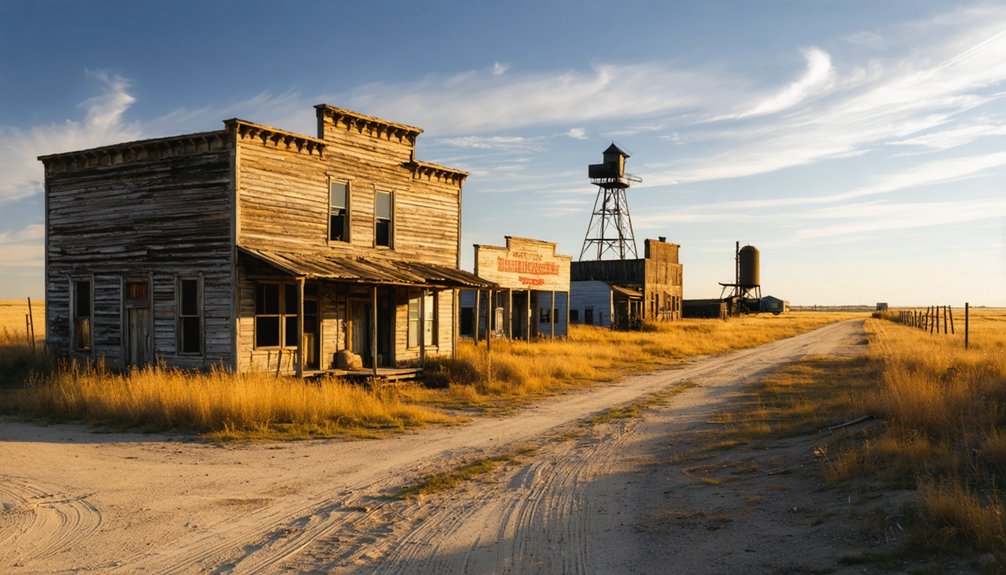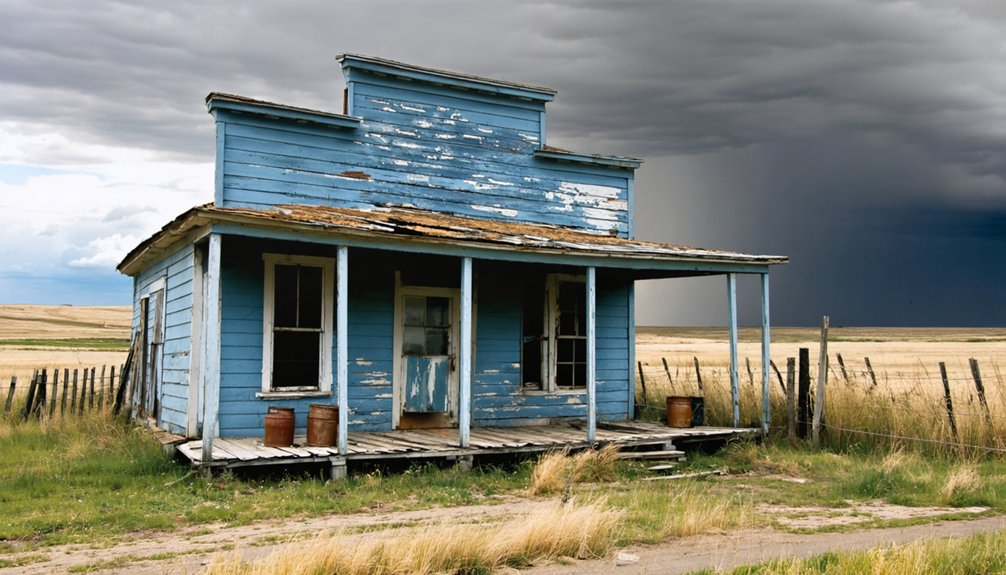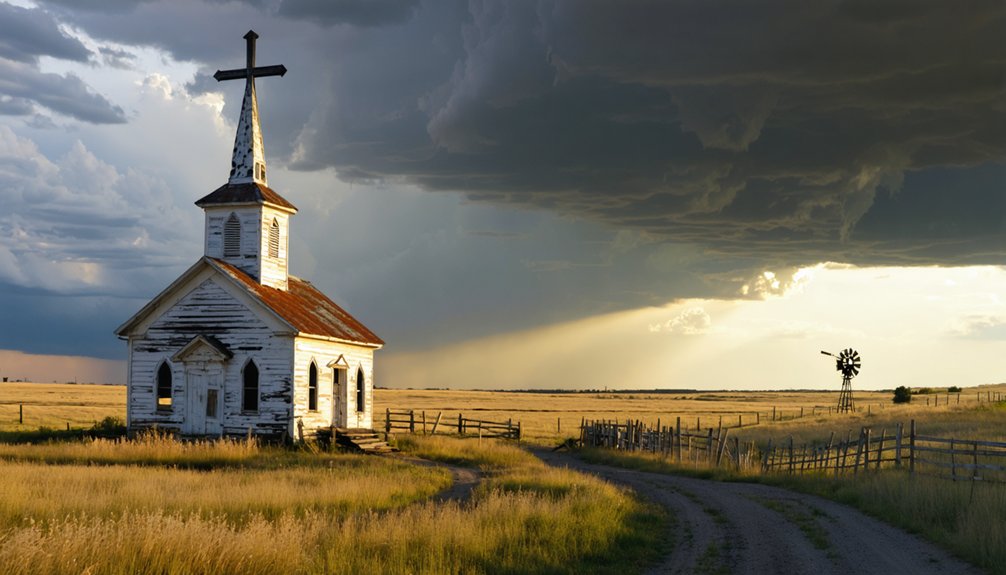You’ll find Fair View’s ghost town remains in Pennington County, South Dakota, where it once thrived as a bustling sawmill town in the 1880s. The settlement supported under 100 residents who worked at operations like Frink’s mill, processing timber for regional construction. Today, only scattered rock foundations and industrial remnants mark the site, which sits on private property. The town’s rich history of mining and lumber operations reveals fascinating details about South Dakota’s economic evolution.
Key Takeaways
- Fair View was established in 1887 as a sawmill town in Pennington County, South Dakota, with its economy centered around timber operations.
- The town reached its peak during the gold rush years with 10,000-25,000 residents before transitioning to a lumber-based economy.
- Only scattered rock foundations and industrial remnants remain today, with the site largely overgrown and located on private property.
- The final sawmill closure in 1952 marked the end of major industry, leading to the town’s abandonment.
- The ghost town site lacks tourism infrastructure and requires landowner permission for exploration, with minimal physical remains visible.
The Rise and Fall of Fair View
While many Black Hills communities rose and fell with the timber industry, Fair View’s story began in 1887 when settlers established this sawmill town in Pennington County, South Dakota.
Like many early settlements driven by dreams of prosperity, settlers came to Fair View seeking new economic opportunities and a fresh start.
You’ll find that Fair View’s economic sustainability centered on its sawmill operations, which supported a modest population of under 100 residents through lumber production and related trades.
The town’s community resilience was strengthened by its strategic location near railroad spurs, enabling efficient timber shipment to broader markets.
Fair View featured three houses and essential infrastructure during its peak, but like many resource-dependent towns, it couldn’t survive the depletion of local timber.
Like many of the over six hundred ghost towns in the Black Hills region, Fair View’s buildings eventually fell into ruins.
Once the sawmill closed and railroad services ended, residents moved away for work opportunities elsewhere.
Life in a Black Hills Sawmill Town
As Fair View’s sawmill hummed with activity, the town’s daily rhythms centered around the demanding work of timber production.
You’d find workers living in modest cabins near the mill, rising with the sun to begin their labor-intensive duties of felling trees, hauling logs, and operating machinery. The sawmill operations transformed raw timber into valuable lumber, achieving an impressive 95% efficiency rate. The Frink sawmill construction in 1918 marked a significant economic shift for the town. The local bartering economy helped sustain workers through difficult times, as employee credit purchases kept families afloat during the Depression.
Sawmill workers toiled from dawn, transforming forests into lumber with remarkable precision and unwavering dedication to their craft.
The community dynamics revolved around this bustling industry, where you’d witness the gradual shift from horse-drawn logging to motorized transport.
Workers gathered for social events, while the mill owner even built cabins for travelers in the 1920s. The sawmill’s success attracted new businesses and visitors, including President Coolidge in 1927, making Fair View a crucial hub in the Black Hills’ timber industry.
What Remains Today
If you’re hoping to explore Fair View today, you’ll find only scattered rock foundations of pioneer cabins and remnants of old industrial sites like sawmills on restricted land.
You can still spot traces of the town’s mining heritage through abandoned equipment and processing materials near former mill locations, though access is limited due to the nearby Fallon Naval Air Station. Like the Longhorn Saloon building that remains standing in Scenic, South Dakota, these remnants offer glimpses into the area’s past. The site’s historic Nevada Hills mine once processed 200 tons of ore daily during its peak operations.
The site’s isolated location and decades of natural reclamation have left most structures in ruins, with no intact homes or commercial buildings standing among the deteriorating foundations.
Physical Site Assessment
Since the passage of time has taken its toll, Fair View’s physical remains are now minimal and largely inaccessible to the public. You’ll find the site on private property, where prairie grasses and soil erosion have steadily obscured most archaeological findings.
Without active preservation efforts, the few remaining foundational traces and scattered artifacts continue to deteriorate. Like Owanka’s lone grain elevator structure, Fair View’s decline has left few traces of its once-thriving community.
Unlike other Black Hills ghost towns with standing structures, Fair View’s remnants are particularly sparse.
Preservation challenges include harsh South Dakota weather conditions, vegetative overgrowth, and wildlife activity that disturb surface materials.
You’ll need landowner permission to explore the site, as it’s primarily accessed via unpaved rural roads.
While historical societies maintain interest in Fair View, there’s no tourism infrastructure or interpretive signage to guide visitors through this piece of prairie history.
Structural Remnants Visible
The structural remnants of Fair View tell a sparse story of its frontier past.
Today, you’ll find minimal physical evidence of this once-bustling sawmill town, as structural preservation efforts haven’t been prioritized over the years. The town’s active sawmill operations began around 1887.
While community interest in Fair View’s history remains, the site offers few tangible connections to its logging heritage.
When exploring the area, you’ll discover:
- Foundation traces from the original sawmill operation
- Scattered debris that marks former building locations
- Terrain features that indicate where structures once stood
Much like the collapsing church in Capa, most original structures have deteriorated beyond recognition.
Unlike some South Dakota ghost towns that maintain visible structures, Fair View’s physical remains are significantly limited.
Your best chance of understanding the town’s layout comes from historical photographs and written accounts, particularly those found in “Cow-boys and Colonels,” which document its earlier days.
Access and Location Details
Locating Fair View presents unique challenges for modern-day explorers, as historical records show significant confusion between this site and the existing town of Fairview in Lincoln County.
The historical ambiguity surrounding Fair View’s exact whereabouts has led to ongoing location confusion among researchers and history enthusiasts. Historical satellite records provided by Sentinel-2 Cloudless have not revealed definitive traces of the settlement.
While Fairview, South Dakota sits at coordinates 43.22222° N, 96.48944° W along the Big Sioux River at an elevation of 1,230 feet, Fair View’s true location remains a mystery.
You’ll find that documentation from 1887 mentions Fair View in Pennington, but modern maps don’t show this settlement.
If you’re planning to explore the area, you should know that unlike other documented ghost towns in South Dakota, Fair View lacks clear geographical markers or remaining structures to guide your visit.
Historical Significance

You’ll find Fair View’s roots in its role as a sawmill town, established around 1887 when lumber operations became vital to the region’s development.
While the town wasn’t directly involved in mining, it likely supported the broader Black Hills mining economy by providing essential timber products.
The town’s relatively brief existence mirrors many boom-to-bust settlements of the era, though its precise timeline remains somewhat unclear beyond its late 1880s peak.
Sawmill Town Origins
Nestled in the Black Hills region of South Dakota, Fair View emerged as a bustling sawmill town in 1887, establishing itself as an important hub for timber processing and distribution.
As mining activities declined in surrounding areas, the town’s sawmill technology and timber transportation capabilities became essential for supporting regional construction and development.
The town’s economic foundation rested on three key elements:
- Strategic railroad connections that enabled efficient lumber distribution to broader markets
- Advanced sawmill operations, including Frink’s mill, which served as the primary economic driver
- Extensive infrastructure development, including worker housing and a post office
You’ll find that Fair View’s establishment perfectly timed with the region’s timber boom, positioning the town as a critical player in the Black Hills’ rapid expansion during the late 19th century.
Mining Community Connections
While Fair View’s sawmill operations anchored the town’s economy, its deep connections to the region’s mining industry played an equally vital role in shaping its destiny.
You’ll find that the town’s development paralleled the evolution of mining techniques in the Black Hills, from early placer mining to sophisticated hard rock operations.
The community’s strategic location in Pennington County positioned it near important mining operations like the Fairview and Inca mines, allowing residents to benefit from the industry’s growth.
As mining companies provided essential community support through infrastructure development and economic opportunities, Fair View’s residents found themselves at the crossroads of timber and mineral wealth.
The town’s proximity to major mining hubs meant you could access both industries’ opportunities while maintaining your independence.
Boom-to-Bust Timeline
Fair View’s story unfolds through a dramatic timeline of booms and busts that shaped its destiny in the Black Hills.
You’ll find that population shifts followed the region’s economic pulses, starting with the mid-1870s gold discovery that drew thousands of fortune seekers.
Mining techniques evolved from initial prospecting to established hard rock operations, complete with ore processing mills charging $6 per ton.
- 1870s-1880s: Peak population of 10,000-25,000 during gold rush years
- Early 1900s: Shift to lumber industry as mining declined
- 1952: Final sawmill closure marked the end of major industry
You can trace Fair View’s decline through the closure of its railroads, the exodus of workers, and eventual abandonment, leaving behind only foundations and memories of its once-bustling streets.
Location and Geography

Situated along the Big Sioux River in Lincoln County, South Dakota, you’ll find the small town of Fairview at coordinates 43°13′20″N, 96°29′22″W. At an elevation of 1,230 feet above sea level, this scenic river valley settlement encompasses just 0.09 square miles of land area.
The town’s geographic features reflect its Great Plains heritage, with gently rolling terrain characteristic of the region. You can spot the Big Sioux River forming a natural boundary between South Dakota and Iowa, with the nearby community of Beloit, Iowa lying about 6 miles northwest.
The picturesque setting that inspired Fairview’s name in 1886 remains evident today, as you observe the natural plains environment and valley topography that have defined this location since its founding.
Economic Legacy
Like many frontier settlements of its era, Fair View’s economic story began with the promise of mineral wealth in the late 1800s, as prospectors sought gold and silver deposits throughout the region.
When mining declined, the community showed economic resilience by diversifying into timber operations and establishing essential services.
You’ll find evidence of community adaptation through three major economic phases:
- Initial mining operations with gold and silver extraction
- Shift to timber industry with sawmill operations
- Development of tourism and service-based businesses in the 1920s
Despite these efforts at economic diversification, Fair View ultimately couldn’t sustain itself when primary industries failed.
Today, abandoned structures and remnants of mining operations serve as silent testimonies to the town’s boom-and-bust cycle, reflecting broader economic patterns that shaped many Black Hills communities.
Visiting the Ghost Town Site

When planning a visit to this location, it’s important to understand that Fairview, South Dakota isn’t actually a ghost town but rather a small, inhabited community along the Big Sioux River.
Don’t fall for ghost town myths – this town of 61 residents continues to thrive since its establishment in 1886.
If you’re interested in exploring the area, you’ll find Fairview at an elevation of 1,230 feet, where you can enjoy views of the scenic valley that inspired its name.
Here are some visitation tips: check out the Big Sioux River, drive through the surrounding countryside, and visit nearby Beloit for additional historical context.
For genuine ghost town enthusiasts, you might want to research Fair View in Pennington County instead, which was an actual abandoned settlement from 1887.
Frequently Asked Questions
Were There Any Notable Accidents or Tragedies in Fair View’s History?
Through empty prairie winds, you won’t find records of ghostly encounters or tragic events – there’s no historical evidence that Fair View, South Dakota ever existed as a real town.
What Was the Maximum Population of Fair View During Its Peak?
You’ll find that during the peak years of population growth in the late 1800s, the town reached between 50-75 residents, though exact records from this frontier community aren’t completely certain.
Did Any Famous Outlaws or Historical Figures Ever Visit Fair View?
You won’t find any confirmed outlaw sightings or historical visits to Fair View in the records. While famous figures traveled through nearby Black Hills towns, there’s no evidence they stopped here.
What Happened to the Residents After the Town Was Abandoned?
You’d think everyone vanished into thin air, but most residents relocated to nearby towns like Mystic and Keystone, seeking mining work and better opportunities while their community legacy lived on through descendants.
Were There Any Schools or Churches Established in Fair View?
You won’t find records of historic education or spiritual significance here – there’s no evidence of schools or churches being established in this short-lived town’s limited infrastructure and community development.
References
- https://www.youtube.com/watch?v=Glucs_Rq8Xs
- https://www.sdpb.org/rural-life-and-history/2023-08-21/some-black-hills-ghost-towns-and-their-origins
- https://www.sdhspress.com/journal/south-dakota-history-2-2/some-black-hills-ghost-towns-and-their-origins/vol-02-no-2-some-black-hills-ghost-towns-and-their-origins.pdf
- https://www.youtube.com/watch?v=_0WNYsFLSLA
- https://www.legendsofamerica.com/mystic-south-dakota/
- https://en.wikipedia.org/wiki/List_of_ghost_towns_in_South_Dakota
- https://b1027.com/south-dakota-has-an-abundance-of-ghost-towns/
- https://en.wikipedia.org/wiki/Manchester
- https://www.nativehistory.info/mystic-south-dakota-mining-timber-legends-of-america/
- https://www.sdpb.org/rural-life-and-history/A-Quick-History-of-the-Lumber-Industry-in-the-Black-Hills



